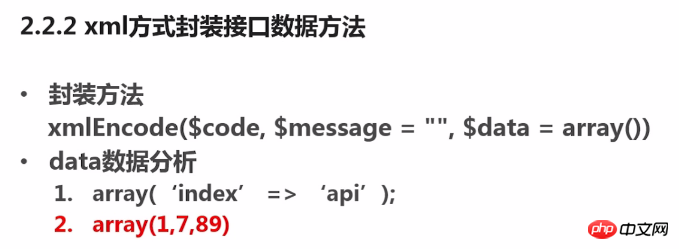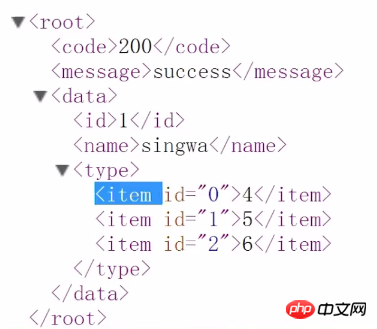이 글에서는 특정 참조값을 갖는 데이터를 XML로 캡슐화하는 방법을 주로 소개합니다. 이제 모든 사람과 공유합니다. 도움이 필요한 친구들이 참조할 수 있습니다

<?php
xml方式封装数据方法
/**
* [xmlEncode description]
* @param [type] $code [description]
* @param [type] $message [description]
* @param array $data [description]
* @return [type] [description]
*/
public static function xmlEncode($code,$message,$data= array()){
if(!is_numeric($code)){
return;
}
$result = array(
'code'=>$code,
'message'=>$message,
'data'=>$data,
);
header("Content-Type:text/html");
$xml ="<?xml version='1.0' encoding='UTF-8'>";
$xml .="<root>";
$xml .=self::xmlToEncode($result);
$xml .="</root>";
echo $xml;
}
public static function xmlToEncode($data){
$xml = $attr "";
foreach ($data as $key => $value) {
//xml的节点不能为数字,如果传默认数组需要处理下标值
if(is_numeric($key)){
$attr = "id='{$key}'";
$key = "item";
}
$xml .="<{$key}>";
$xml .=is_array($value)?self::xmlToEncode($value):$value;
$xml .="</{$key}>";
}
return $xml;
}
$data = array(
'id'=>1,
'name'=>'xinlang',
'type'=>array(),
);
Response::xmlEncode(200,'success',$data);
//注意 xml的节点不能为数字,如果传默认数组需要处理下标值
<item id="0"></item>
yii 독립적인 하위 도메인 이름을 위한 백엔드 구성 방법
위 내용은 xml에 데이터를 캡슐화하는 방법에 대해의 상세 내용입니다. 자세한 내용은 PHP 중국어 웹사이트의 기타 관련 기사를 참조하세요!